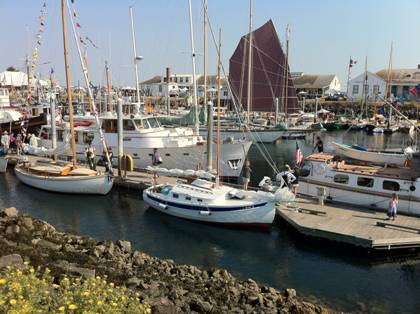
 Custom Search
|
|
| sails |
| plans |
| epoxy |
| rope/line |
| hardware |
| canoe/Kayak |
| sailmaking |
| materials |
| models |
| media |
| tools |
| gear |
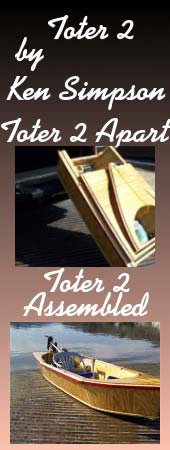 |
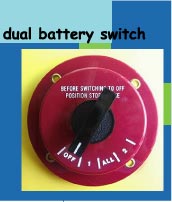 |
| join |
| home |
| indexes |
| classifieds |
| calendar |
| archives |
| about |
| links |
| Join Duckworks Get free newsletter Comment on articles CLICK HERE |
|
|
| Building Tenacious |
by Peter Vansickle
- Coeur d'Alene, Idaho - USA |
If you spend enough time studying different boat plans you can convince yourself that you are choosing a design based on a logical, well developed decision that will suit the uses you intend to give it. Then again, you can just fall in love with a design and forget about pretending to be logical. You can just be passionate instead. My path to choosing a boat design included lots of looking and comparing. However, when I discovered John Welsford’s Penguin design I quickly made my logical, passionate decision. I am mostly a wannabe sailor. I have spent most of 50 years dreaming about sailing. Being a forester in Montana I did not focus my leftover energy on trying to sail, even if Flathead Lake is a marvelous location for doing so. It was not until I lived in Oregon on the shore of a lake close to the Pacific Ocean that I began to think about building a boat. I would have done so then, if I had stayed there long enough. I moved back to Montana for two years and then on to Idaho. Now the time was right and I began to get serious.
While building this boat I also owned a 1988 ComPac 23 that I sailed on Pend Oreille Lake here in Idaho. This is a wonderful boat. It is comfortable in every way and easy to sail. My wife and I spent lots of time enjoying this boat and learning more about sailing. We explored a good deal of the beautiful lake. This experience convinced me more than ever that I really needed to build a boat for myself. The only trouble was that I had to sell Talisman to be able to afford to do so. It does not take long to sell such a nice boat as that. I purchased the plans for my Penguin in June of 2007 from Duckworks. I purchased all of the Okoume and Meranti plywood from Edensaw Woods in Port Townsend, WA in November of that year. It just so happens that my daughter lives near there so a visit to her included a little side trip. After some investigation I discovered that I could drive the 350 miles to visit, rent a U-Haul trailer, purchase the wood there, and return home cheaper than I could have it shipped and still pay for the gas to go and return. Construction began in earnest November 27, 2007. I did use oak for the keelson, but most of the structural lumber for the boat came from local sources. I used mahogany for the center case, the hatches and hatch slides, the companionway frame, and the trim. I was able to get both of these species from local lumber supply places. All of the rest of the structural material is Douglas fir which I got from a local sawmill. I am fortunate to live in Douglas fir country so it is easy to find. This is certainly a great species of wood to use for boat building. I tend to think that too much time and money is spent trying to find the “best” marine building wood. Wooden boats have been built for a very long time using the local species at hand. It makes sense to use the most rot resistant local wood, but unless the builder just wants a certain look many species will do just fine. Building a boat like the Penguin design is a big project, but it is not a difficult one. I found only two steps during construction to be especially challenging for me. Both became good learning opportunities. The first was the garboard which has a compound curve near the bow. Plywood is not supposed to do compound curves. I broke the first piece of plywood I tried to put in place. Then I realized that I would need to steam it to be successful. I am a self taught woodworker. That just means there are lots of skills I learn through trial and error. I am fortunate enough to have a good shop and a sufficient amount of tools for this project. It only took me 40 years of accumulating to reach this stage. Most of my efforts to date had been furniture of one sort or another for my own home. This project is a bit larger than all of those combined, but really no more difficult. I decided that I would need to establish a regular work schedule and stick with it. I became rather tenacious at my efforts and hence, that became the name of the boat. I tell myself that I was still considerate to my wife and spent time doing things she liked to do also. After all, I did not want her to think I had a new mistress. OK, she was not convinced, but I felt better. The plans for the Penguin are very complete and include all of the details necessary. However, there are a few processes that require a bit more know-how. I think I have enjoyed the required research, reading, and asking questions as much as I have the woodworking. In a project of this complexity one should not look just to the next logical step in the process. One needs to look and plan for the steps well beyond. Like any other construction project I’m sure it helps to have done that once before. You know the adage: when you finish you know enough to start. The plans for this boat have clear specifications of materials for many different parts of the boat. It would be easy to spend far more money than is truly necessary by following those plans to the letter. A good example for me was the mast tabernacle. The plans specify stainless steel. I tried at least 6 metal fabricating shops before I found one that would give me a price. I gave a big gulp when I got the price of $600 and decided I could keep looking. I finally settled on mild steel and powder coating. I have a friend who is good at metal working, and with his help I was able to build it myself and have it powder coated all for a total of $99. The same is true for several other parts. It is also fun to take on and develop a new skill. One of my frustrations was trying to determine when I would reach a specific stage in the building process. The time taken was not as important as the scheduling of needed materials. I don’t know how many intermediate goals I set for myself only to find I did not even come close. Either the work just takes longer or life intervenes. I kept thinking that the next step would go more quickly than the last, but that was rarely true. I did try to include some time out for extra activities during the build. One such activity was the annual Port Townsend Wooden Boat Festival. This is an eclectic collection of wooden boats and their enthusiastic owners with a yen for beautiful boats. The collection that arrives includes everything from a small dingy to boats over 100 feet in length. Almost all of these craft get packed into a small and meticulously managed harbor. One cannot attend the show without being inspired somehow. I am sure that each of us has a different view for which boat captures our eye. What attracts one does not turn on a light for another. However, there are a few designs crafted by the right hands that cannot help but be admired by all. There are three boats that stand out for me and served as my own inspirations from this show. The first of these was Iain Oughtred’s Tirrik built and displayed by Tom Regan of Grapeview Point Boat Works, Allyn, Washington. The second boat was a Graham Byrnes Core Sound 17 built by Jan Nicolaisen, SCA No. 47, 49, 51, and 53. The third boat is another Welsford design, a Navigator by Barrett Faneuf, DW, 2006. I am sure I cannot duplicate their quality of work, but each design is high on my future list because of the quality of their efforts. Each of us can use an inspiration from time to time. These three served well for me. They also provided the stimulation for me to show a boat of my own. I’d like to claim that there were several “break through” or “grand” moments during the building of Tenacious, but I cannot. There were certainly moments of satisfaction to realize that the step I just completed came off just as planned. There were also moments when the piece I carefully crafted would fit perfectly if only it were for the port side in stead of starboard and a mirror image of what I just created. The ballast pour came off without a hitch – lots more fun than I thought it would be. The turning cradle I used enabled my wife and me to turn the boat over fairly easily. The mast took only two full days to complete from a single piece of western larch. I am particularly proud of the way the bow shape turned out. The trailer I bought as a derelict came together successfully. The seal between the ballast and the hull was not good enough and I had a leak until I tried again and sealed it completely. The center board did not have enough clearance the first time out and would not drop. That took a rebuild too. I still don’t have the mast rigging figured out completely so the main sail does not raise and lower as easily as it should. The motor I purchased is too big to fit in the motor well as designed. The cabin is very spacious and comfortable. The forward bunk is roomy, comfortable, and a great place to sleep. The original launch was mostly successful with a crowd of local friends and strangers from England to cheer me off. The problems will get fixed with time and the pleasure of using the boat. The single greatest pleasure I’ve had so far was looking up to the dock at the Wooden Boat Festival to see a gentleman say “Good morning. My name is John Welsford. May my wife, Denny, and I come aboard?”
Tenacious at the 2011 Port Townsend Wooden Boat Festival |
 |
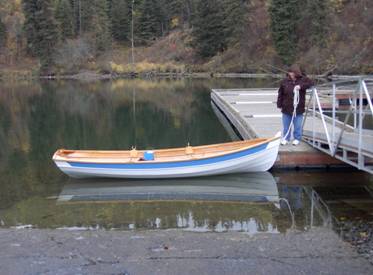 I decided I needed to build a smaller boat first to test my skills and my patience. I spent lots more time looking at plans and chose Arch Davis’ Penobscot 14 plan. This was a fun build with very pleasing results. I purchased all of the wood to build this boat from Emerson Hardwood in Portland, Oregon on a trip to visit my son who lived in Beaverton, Oregon at the time. For this boat I used Douglas fir and oak for the structural members and Okoume marine plywood. I spent 236 delightful hours to build this craft including the mast and oars. I have sailed Marissa on Lake Coeur d’Alene and Pend Oreille Lake here in N. Idaho. It is a great little boat to take myself or grandkids out for an afternoon row or sail.
I decided I needed to build a smaller boat first to test my skills and my patience. I spent lots more time looking at plans and chose Arch Davis’ Penobscot 14 plan. This was a fun build with very pleasing results. I purchased all of the wood to build this boat from Emerson Hardwood in Portland, Oregon on a trip to visit my son who lived in Beaverton, Oregon at the time. For this boat I used Douglas fir and oak for the structural members and Okoume marine plywood. I spent 236 delightful hours to build this craft including the mast and oars. I have sailed Marissa on Lake Coeur d’Alene and Pend Oreille Lake here in N. Idaho. It is a great little boat to take myself or grandkids out for an afternoon row or sail.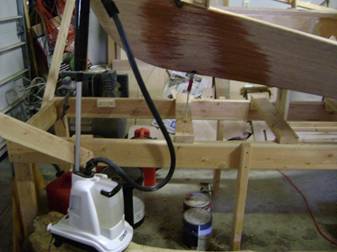 I am sure there are many ways to accomplish this task. I used a clothes steamer with great success. I steamed the focus area for about half an hour before it would bend in two directions. It worked great. The second challenging project was the front of the cabin. This has a rather tight curve on both sides of the cabin front and must also fit the curvature of the foredeck. The cabin side here is made of two layers of plywood built up to form a 6mm (1/4 inch) thick wall. Steaming does the trick well here also.
I am sure there are many ways to accomplish this task. I used a clothes steamer with great success. I steamed the focus area for about half an hour before it would bend in two directions. It worked great. The second challenging project was the front of the cabin. This has a rather tight curve on both sides of the cabin front and must also fit the curvature of the foredeck. The cabin side here is made of two layers of plywood built up to form a 6mm (1/4 inch) thick wall. Steaming does the trick well here also. 